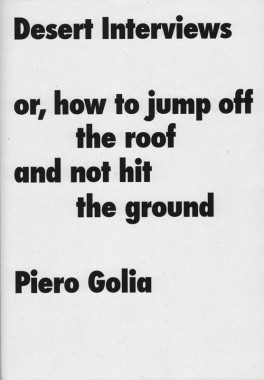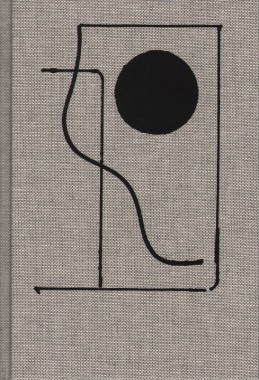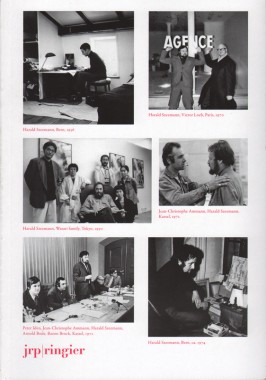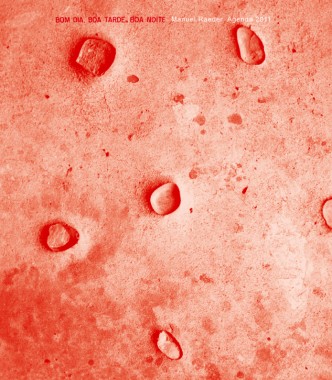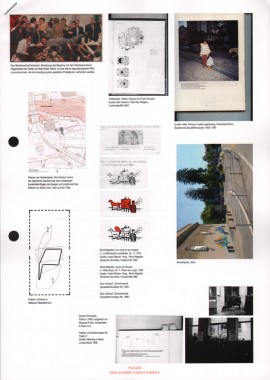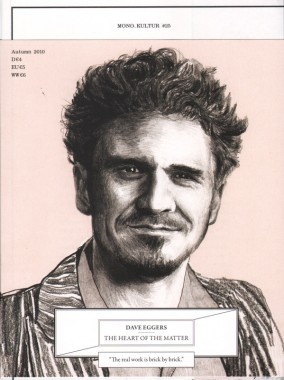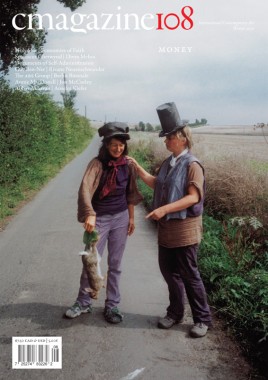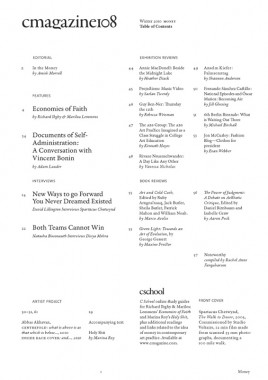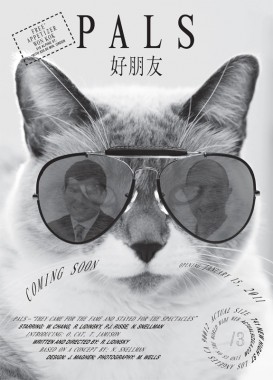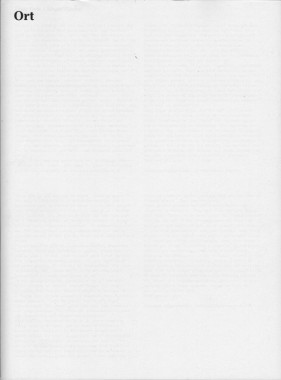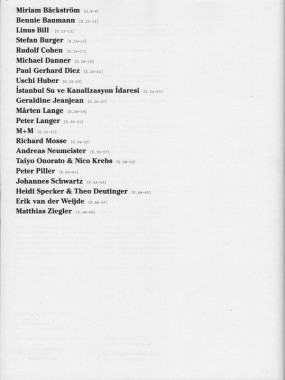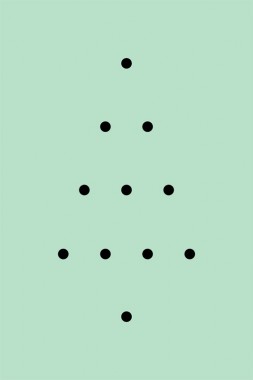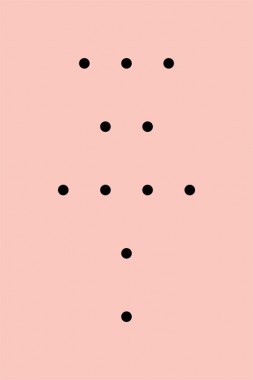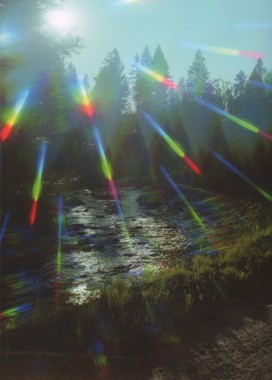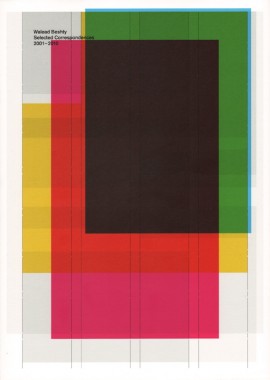Desert Interviews or, how to jump off the roof and not hit the ground
Piero Golia, Desert Interviews or, how to jump off the roof and not hit the ground
Softcover, 100 pp., offset 4/1, 148 x 210 mm
Edition of 2000
ISBN 978-3-03764-106-4
Published by JRP|Ringier
$28.00 ·
This book, composed of discussions between artists, presents a kind of report on this unique “institution:” teaching methods, academic syllabus, and students’ selection are here explained with metaphors, compared with artistic interaction, and equaled to performances. Not unlike Golia’s work itself, the development of the school and its program follow a poetic of the gesture, of the instant, and of actions recalling Fluxus, Gino de Dominicis’ or Paul McCarthy’s works.
As a career’s start, Piero Golia successfully convinced a woman to have his portrait and the words “Piero My Idol” tattooed on her back (tattoo, 2001); soon after, following an invitation to the Tirana Biennale, he rowed across the Adriatic Sea in the opposite direction to migratory movement to reach Albania (”Going to Tirana,” 2000). And, on January 14, 2005, Golia vanished from New York City leaving no documented proof of his whereabouts; he traveled from a place to another, crossing borders without a trace, for resurfacing only on the morning of February 7 at the Royal Academy of Arts in Copenhagen for a unique lecture about his adventurous trip. He now lives in Los Angeles, a place that blurs the boundaries between reality and fiction, making it the perfect setting for his exploration into the process of myth-making and his ironic outlook on contemporary society.
Wait to Wait
Boris Groys and Andro Wekua, Wait to Wait
Hardcover, 160 pp., offset 4/1, 135 x 196 mm
English and German
Edition of 2000
ISBN 978-3-03764-021-0
Published by JRP|Ringier, CK editions
$28.00 ·
Phenomena such as loneliness, doubles, repetitions, mirror images, and waiting are the central themes of this conversation, illustrated by pictures of the two installations and several collages by Wekua.
Individual Methodology
Harald Szeemann, Individual Methodology
Softcover, 240 pp., offset 2/1, 160 x 230 mm
Edition of 2000
ISBN 9783905829099
Published by JRP|Ringier
$25.00 ·
Bom Dia, Boa Tarde, Boa Noite (Manuel Raeder Agenda 2011)
Manuel Raeder, Bom Dia, Boa Tarde, Boa Noite (
Manuel Raeder Agenda 2011)
Softcover, 128 pp. + 4/1 insert, offset 1/1, 140 x 160 mm
Edition of 1000
Agenda/calendar/notebook 2011
Published by Manuel Raeder
$29.00 ·
palaver
Florian Dombois and Eran Schaerf, palaver
Stapled, 80 pp., digital 4/1, 210 x 297 mm
English and German
Edition of 1000
ISBN 978-3-033-02145-7
Published by Kunsthalle Bern
$15.00 ·
Mono.Kultur 25
Mono.Kultur 25, Dave Eggers
Poster and wrap-around cover, offset 3/3, 150 x 200 mm [700 x 1000 mm unfolded]
Edition of 5000
ISSN 1861-7085
Published by Mono.Kultur
$9.00 ·
C Magazine 108
C Magazine 108, Money
Softcover, 64 pp., offset 4/1, 210 x 295 mm
Edition of 2200
ISSN 1480-5472
Published by C Magazine
$7.50 ·
Feature articles in issue 108 include Economies of Faith, by Richard Ibghy and Marilou Lemmens, looking at works by Mark Boulos, Melanie Gilligan and Olivia Plender that explore the relationship between the workings of the market and the spiritual belief, and Documents of Self-Administration: A Conversation with Vincent Bonin, by Adam Lauder, about the exhibition Documentary Protocols at the Leonard & Bina Ellen Gallery. This issue also includes interviews with British artist Spartacus Chetwynd, by David Lillington, and Canadian artist Divya Mehra, by Natasha Bissonauth.
Reviews include Shannon Anderson on Anselm Kiefer’s Palmsonntag at the Art Gallery of Ontario; Saelen Twerdy on Projections: Music Video at Musée d’art contemporain de Montréal; Kenneth Hayes on Group ABS at Gallery Siz in Rijeka, Croatia; Vanessa Nicholas on Rivane Neuenschwander’s A Day Like Any Other at the New Museum; Heather Diack on Annie MacDonell’s Beside the Midnight Lake at Katharine Mulherin Contemporary Art Projects; Rebecca Weisman on Guy Ben-Ner: Thursday the 12th at Mass MoCA; Jill Glessing on Fernando Sánchez Castillo: National Episodes and Óscar Muñoz: Becoming Air at Círculo de Bellas Arte, Madrid; Michael Birchall on the 6th Berlin Biennale; and Evan Webber on Jon McCurley: Fashion Blog — Clothes for President.
PALS (Coming Soon)
Richard Lidinsky and Jonathan Maghen, PALS (Coming Soon)
Océ print/poster, 1/0 on pink paper, 20 x 28 inches [21 x 29 inches framed*]
Edition of 3 + 2 proofs, numbered
Published by Textfield
$123.00 ·
Pals (full title: Pals for Life / Life for Pals) is a teleplay about the dialectics of friendships under the strain of artistic endeavor. Shot principally in January 2011 at the Actual Size gallery in Los Angeles’ Chinatown, the approx. 34-minute video — told from the point of view of a traditional studio audience television program — revels in the angst and emotion of 4 friends/lovers who must install their respective art works in the presence of frenemies large and small. Each Pal is named after a specific human being, though the story implies that these pals are simple archetypes from a vast universe of narcissistic micro-movements.
*PALS (Coming Soon) print/poster ships unframed; trim size is an exact fit for this frame.
Ort
Elmar Bambach, Martin Fengel, Jörg Koopman, Julia Marquardt and Birgit Vogel, Ort
Softcover, 56 pp., offset 4/1, 240 x 325 mm
Edition of 500
ISBN 978-3-00-032613-4
Published by Ein Magazin über Orte
$18.00 ·
Photographs by Miriam Bäckström, Bennie Baumann, Linus Bill, Stefan Burger, Rudolf Cohen, Michael Danner, Paul Gerhard Diez, Uschi Huber, Iski Behörde, Geraldine Jeanjean, Mårten Lange, Peter Langer, M + M, Richard Mosse, Andreas Neumeister, Taiyo Onorato & Nico Krebs, Peter Piller, Johannes Schwartz, Heidi Specker & Theo Deutinger, Erik van der Weijde, Matthias Ziegler. Texts by Simon Bieling and Swantje Grundler.
Totaalvoetbal (Total Football)
Jonathan Maghen, Totaalvoetbal (Total Football)
Océ print/poster, 1/0 on green paper, 24 x 36 inches
Edition of 11 + 2 proofs, numbered
Published by Textfield
$21.00 ·
The tactical success of Totaalvoetbal depends largely on the adaptability of each footballer within the team, in particular the ability to quickly change positions depending on the on-field situation. The strategy requires players to be comfortable playing multiple positions; hence, placing high technical and physical demands on them. Totaalvoetbal was widely and successfully adopted by both club and national teams in winning tournaments (including the World Cup), though it ultimately (and ironically) failed to deliver a World Cup title to the Dutch national football team. Also see Catenaccio.
Emmett
Ron Jude, Emmett
Softcover, 80 pp., offset 4/4, 6.75 x 9.5 mm
Edition of 1000
ISBN 978-0-9823653-2-8
Published by The Ice Plant
$30.00 ·
—Jean-Paul Sartre
Jude’s latest book project, Emmett, brings new life to a selection of his own early photographs, made in the early 1980s in central Idaho. Enhanced by special-effects filters and cheap telephoto lenses, the pictures include hazy scenes of a summertime drag race, a forest across changing seasons, midnight horror films on TV and a Nordic-looking teenager who appears as a specter from the artist’s past. Edited here nearly 30 years after its making, this experimental body of work acquires unexpected nuance and humor, and has the serendipitous qualities of a dream –memories reorganized into a fictionalized narrative, imagery suffused with both an unsettling melancholy and the glow of youthful reverie. Related conceptually to and residing thematically between his two previous books — Alpine Star and Other Nature — Emmett achieves an aesthetic inspired by equal parts Motörhead and Jean-Paul Sartre.
Selected Correspondences 2001-2010
Walead Beshty, Selected Correspondences 2001-2010
Softcover, 128 pp., offset 4/1, 210 x 297 mm
Edition of 2000
ISBN 978-88-6208-135-1
Published by Damiani
$49.00 ·
